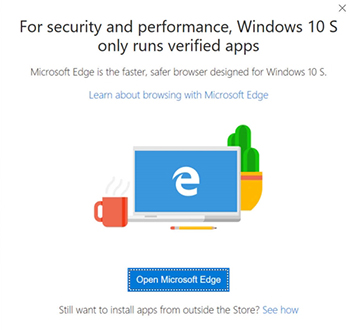Posey's Tips & Tricks
The Verdict Is In on Windows 10 S
Thankfully, it looks like Microsoft has an out for those who want the full-fledged Windows 10 on their Surface Laptop.
As I'm sure you have heard by now, Microsoft has introduced a Surface laptop that is targeted primarily toward educational environments. In an effort to compete with the Chromebook, these laptops run a newly introduced version of Windows 10 called Windows 10 S.
The general consensus of the reviews that have been published over the last few weeks has been that the Surface Laptop is great, but that Windows 10 S is awful.
There are two main problems that have been cited with regard to Windows 10 S. The first of these problems is that Microsoft's marketing plan just doesn't make sense. Supposedly, Microsoft introduced the Surface Laptop in an effort to compete with Chromebooks. Like Windows 10 S, Chromebooks run an operating system that is very limited with regard to its capabilities. The problem, however, is that while Chromebooks tends to be relatively inexpensive, the Surface Laptop is a premium device. A quick Web search revealed that some Chromebooks are currently selling for less than $150, and the average Chromebook price is around $300. In contrast, the starting price for the Surface Laptop is $999, with high-end models costing as much as $2199. The point is that nobody wants to pay a couple thousand dollars for a laptop that runs an operating system whose very claim to fame is that its abilities are extremely limited.
The other problem with the Surface Laptop is that Microsoft seems to have ignored some painful lessons from the past. You might recall Windows RT, the ill-fated operating system that ran on some of the first-generation Surface tablets. Windows RT was similar to Windows 10 S in that it could only run apps from the Windows Store. To say that Surface RT tablets were of failure is to put it mildly. In fact, the devices were the major reason for Steve Ballmer leaving Microsoft. According to some reports, Ballmer was fired after Microsoft lost $900 million on Surface RT tablets.
Thankfully, Microsoft has given its customers a way out. Those who purchase the Surface Laptop can upgrade to Windows 10 Pro, rather than being stuck running Windows 10 S. The trick to making the switch is to download an application from the Internet, rather than going through the Windows Store. When you try to install the application, you will see a warning message telling you that for security and performance reasons, Windows only runs verified apps. This is Microsoft's way of saying that you can only install apps from the Windows Store. You can see what the message looks like in the figure below.
 [Click on image for larger view.] Figure 1. You will see this warning message if you try to install an application that came from somewhere other than the Windows Store.
[Click on image for larger view.] Figure 1. You will see this warning message if you try to install an application that came from somewhere other than the Windows Store.
If you look closely at the figure, you will notice a line of text at the very bottom that says "Still want to install apps from outside of the Store? See how." Clicking on this link takes you to a screen that shows you a comparison between Windows 10 S and Windows 10 Pro. This screen also gives you the option of upgrading to Windows 10 Pro.
In spite of the ease of upgrading to Windows 10 Pro, there are two things that you need to know about the process. First, the process is irreversible. If for some reason you decide that you don't like Windows 10 Pro, you can't go back to Windows 10 S.
A second thing that you need to know about upgrading to Windows 10 Pro, is that Microsoft is making the upgrade free to Surface Laptop customers until the end of 2017. After that, there will be a fee for upgrading. According to some of the tech blogs, the cost after the end of the year will be $49. There are also rumors that free upgrades will only be offered on Microsoft devices, and that Windows 10 S devices from other manufacturers will not be eligible for a free upgrade to Windows 10 Pro.
It remains to be seen how well Windows 10 S will fare in the marketplace. My guess is that the Surface Laptop will sell reasonably well, but that almost no one will run Windows 10 S on the device.
About the Author
Brien Posey is a 22-time Microsoft MVP with decades of IT experience. As a freelance writer, Posey has written thousands of articles and contributed to several dozen books on a wide variety of IT topics. Prior to going freelance, Posey was a CIO for a national chain of hospitals and health care facilities. He has also served as a network administrator for some of the country's largest insurance companies and for the Department of Defense at Fort Knox. In addition to his continued work in IT, Posey has spent the last several years actively training as a commercial scientist-astronaut candidate in preparation to fly on a mission to study polar mesospheric clouds from space. You can follow his spaceflight training on his Web site.